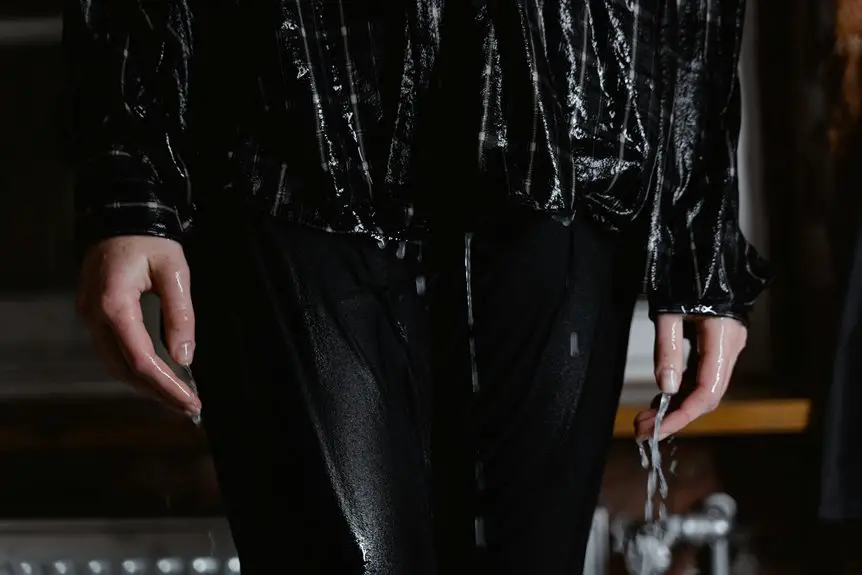You might not realize that Tencel, also known as Lyocell, can manage moisture far better than cotton does. While both fibers feel soft, their ability to handle sweat and humidity differs greatly. If you’ve ever wondered why some fabrics keep you dry while others feel damp and uncomfortable, understanding these differences could change how you choose your next shirt or workout gear. Let’s explore what makes one fiber outperform the other in moisture management.
Table of Contents
Key Takeaways
- Tencel/Lyocell wicks moisture away more effectively than cotton, keeping skin drier and reducing sweat-related discomfort.
- Cotton absorbs more moisture but retains it longer, often causing a clammy, damp feeling after sweating.
- Tencel dries significantly faster than cotton, making it ideal for activewear and humid conditions.
- Tencel’s smooth fibers enhance ventilation and temperature regulation better than cotton’s hollow, moisture-holding fibers.
- For sensitive skin, Tencel’s moisture management reduces irritation compared to cotton’s prolonged moisture retention.
Understanding the Fiber Composition of Tencel and Cotton
When you look closely at Tencel and cotton fibers, you’ll see they come from very different sources.
Cotton fibers grow naturally on cotton plants, featuring a twisted, ribbon-like fiber structure that’s hollow in the center. This structure impacts how cotton feels and behaves in fabrics.
Cotton fibers have a naturally twisted, ribbon-like structure with a hollow center, influencing fabric texture and performance.
Tencel, also known as Lyocell, is a man-made fiber derived from wood pulp, usually eucalyptus. Its production process involves dissolving the pulp in a non-toxic solvent, then extruding it through fine holes to form smooth, round fibers.
This unique fiber structure gives Tencel a silky, strong quality. Understanding these fundamental differences in fiber structure and production process helps you appreciate why Tencel and cotton perform differently in textiles, especially in moisture management applications.
Comparing Moisture Absorption Capabilities
Although both Tencel and cotton absorb moisture, they do so in distinct ways that affect your comfort. Tencel fibers have superior moisture retention yet dry faster, while cotton absorbs more but holds moisture longer. This means you’ll feel less clammy in Tencel garments after sweating.
| Property | Tencel (Lyocell) | Cotton |
|---|---|---|
| Moisture Absorption | Moderate | High |
| Moisture Retention | Low | High |
| Drying Speed | Fast | Slow |
| Feel When Wet | Smooth, less sticky | Heavier, clingy |
| Suitability | Activewear, humid climates | Casual wear, dry climates |
Choosing Tencel helps you stay dry and comfortable due to its efficient moisture management and faster drying speed.
Breathability and Temperature Regulation Differences
Because your body temperature fluctuates throughout the day, choosing the right fabric for breathability and temperature regulation can make a big difference in your comfort.
Both Tencel/Lyocell and cotton are breathable fabrics, but they handle temperature control in distinct ways. Tencel/Lyocell fibers have a smooth surface that allows air to flow easily, enhancing ventilation and keeping you cooler. They also wick moisture away quickly, helping regulate your temperature more effectively.
Cotton, while breathable, tends to retain moisture longer, which can leave you feeling damp and less comfortable when temperatures rise.
Environmental Impact and Sustainability Factors
Since many consumers today prioritize eco-friendly choices, understanding the environmental impact and sustainability of Tencel/Lyocell versus cotton is essential. You’ll find that Tencel/Lyocell often excels due to sustainable farming and closed-loop production processes, reducing resource consumption and carbon footprint. Cotton, while natural, typically requires more water and pesticides, impacting its eco-friendly status. Both materials have biodegradable properties, but lifecycle assessment often favors Tencel/Lyocell for overall sustainability. Check the table below to compare key factors:
| Factor | Tencel/Lyocell | Cotton |
|---|---|---|
| Sustainable Farming | Yes, uses eco friendly practices | Often intensive, high water use |
| Production Processes | Closed-loop, low waste | Conventional, higher waste |
| Resource Consumption | Low water & energy | High water & pesticide use |
| Carbon Footprint | Lower | Higher |
| Environmental Certifications | Common (e.g., FSC, OEKO-TEX) | Less frequent |
Durability and Care Requirements
When you choose between Tencel/Lyocell and cotton, understanding their durability and care requirements can help you get the most from your fabrics.
Here’s a quick lifespan comparison and care instructions overview:
- Tencel/Lyocell tends to resist pilling and maintains strength after multiple washes, giving it a longer lifespan.
- Cotton wears down faster, especially with frequent washing and exposure to harsh detergents.
- For care, Tencel/Lyocell often requires gentle washing in cold water and air drying to preserve fabric integrity.
- Cotton is more forgiving with care instructions, handling machine washing and higher heat drying without significant damage.
Knowing these factors guarantees you pick the fabric that suits your lifestyle and care preferences best.
Cost and Market Availability
When choosing between Tencel/Lyocell and cotton, you’ll notice a difference in price, with cotton generally being more affordable.
You’ll also find cotton widely available in most markets, while Tencel/Lyocell may be less common and sometimes pricier.
Understanding these factors can help you decide which fabric fits your budget and sourcing needs.
Price Comparison
Although Tencel/Lyocell often comes with a higher price tag than cotton, its superior moisture-wicking properties can justify the investment depending on your needs.
When comparing price trends and budget considerations, keep these points in mind:
- Cotton generally remains more affordable due to mass production and long-standing market presence.
- Tencel/Lyocell’s cost is higher because of its eco-friendly production and advanced fiber technology.
- Over time, Tencel/Lyocell prices show a slight decrease as demand grows and manufacturing scales up.
- Your choice depends on balancing upfront cost against long-term benefits like durability and moisture management.
Availability Differences
Price plays a significant role in your decision, but availability can impact it just as much.
When choosing between Tencel/Lyocell and cotton, you’ll notice differences in how widely each fiber is sourced and produced. Cotton benefits from extensive global sourcing and well-established regional production, making it easier to find and often more affordable.
Tencel/Lyocell, on the other hand, relies on more specialized manufacturing processes and fewer production hubs, which can limit its availability depending on your location. This sometimes means longer lead times and higher costs.
If you need moisture-managing fabric quickly or in large quantities, cotton’s widespread availability might suit you better. However, if you’re willing to navigate niche markets, Tencel/Lyocell offers unique benefits despite less regional production.
Consumer Preferences Based on Usage Needs
When you sleep hot, you’ll appreciate fabrics that manage moisture well to keep you cool through the night.
If you have sensitive skin, choosing materials that are gentle and breathable can make a big difference in comfort.
Let’s explore how Tencel/Lyocell and cotton stack up based on these needs.
Sleep Temperature Impact
Since your sleep temperature greatly influences comfort, choosing between Tencel/Lyocell and cotton hinges on how each fabric manages moisture and heat.
Both fabrics impact your sleep quality by regulating temperature, but their performance varies. Tencel/Lyocell excels in moisture wicking and breathability, keeping you cooler when you sweat. Cotton, while breathable, tends to retain moisture longer, which can affect temperature control.
Consider these points for better sleep temperature management:
- Tencel/Lyocell absorbs moisture quickly, promoting dryness and coolness.
- Cotton absorbs moisture but dries slower, possibly causing warmth.
- Your personal temperature preference—cool or warm—guides the best choice.
- Sleep quality improves when your bedding supports consistent temperature control.
Choose based on how you feel during the night for ideal rest.
Skin Sensitivity Benefits
Two key fabric choices like Tencel/Lyocell and cotton offer distinct benefits for sensitive skin, helping you select what suits your needs best.
If you’re prone to skin irritation, Tencel/Lyocell’s hypoallergenic properties make it a strong contender. It’s naturally smooth and moisture-wicking, reducing the chance of irritation caused by trapped sweat.
Cotton, on the other hand, is breathable and soft but may retain moisture longer, which sometimes leads to discomfort for sensitive skin.
If you want minimal irritation and enhanced comfort during active use or sleep, Tencel/Lyocell might be your fabric of choice.
However, if you prefer a familiar, natural feel and don’t experience strong skin sensitivity, cotton remains a reliable option.
Ultimately, your skin’s reaction and usage needs should guide your decision.
Frequently Asked Questions
Can Tencel or Cotton Cause Skin Allergies?
Sometimes, fabrics might play tricks on your skin, causing mild skin irritation. Both Tencel and cotton are gentle, but if you want allergy prevention, you should always check for sensitivities and choose hypoallergenic options carefully.
Is Tencel Suitable for Children’s Bedding?
You’ll find Tencel’s durability perfect for children’s bedding, offering long-lasting use. Plus, its softness and moisture-wicking properties guarantee children’s comfort, keeping them cozy and dry all night long without irritation or overheating.
How Do Tencel and Cotton Feel Against Sensitive Skin?
You’ll notice Tencel offers a smoother softness comparison against sensitive skin, reducing skin irritation more effectively than cotton. Cotton feels soft too but might sometimes cause slight irritation, especially if your skin is highly sensitive.
Are There Any Certifications to Verify Tencel’s Eco-Friendliness?
Wondering if Tencel’s eco claims hold up? You’ll want to look for Tencel certifications like the FSC and OEKO-TEX labels—they prove the fabric meets strict eco friendly standards you can trust every time.
Can Tencel Be Blended With Cotton for Better Moisture Control?
You can blend Tencel with cotton using advanced blending techniques to reduce moisture retention. This combo leverages Tencel’s moisture-wicking and cotton’s breathability, creating fabrics that keep you drier and more comfortable throughout the day.
- Does Chiffon Fabric Stink - July 15, 2025
- Does Chiffon Fabric Affect the Economy - July 15, 2025
- Does Cotton Fabric Have a Nap - July 15, 2025







